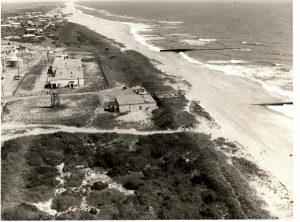
Members of the new Buxton Civic Association (BCA) introduced themselves to the local community at a public meeting on Wednesday that became heated at times due to its focus on the growing environmental and public safety issues at Buxton Beach.
Cape Hatteras National Seashore Superintendent David Hallac attended the meeting alongside five BCA Board Members, and shared a presentation that outlined the current issues along a roughly 500-yard stretch of shoreline at the end of Old Lighthouse Road.

The 50-acre site that borders the Cape Hatteras Lighthouse was the home of a Navy base from 1956 until 1982 and a U.S. Coast Guard base from 1984 until 2010. Both military branches used the site under a Special Use Permit issued by the National Seashore. “Basically, what it said was use it, and return it the way we gave it to you,” said Hallac.
In 1998, the U.S. Army Corps of Engineers (Corps) approved the Buxton Beach area as a Formerly Used Defense (FUDS) site, which allowed the Corps to address environmental liabilities that resulted from Department of Defense activities.
As a result, the Corps spent years removing abandoned structures, roads, utilities, and 4,006 tons of petroleum-contaminated soils (PCS) in the early 2000s. Meanwhile, the Coast Guard removed additional structures linked to their activities at the site, as well as some of the wastewater facilities in the 2010s.
But in September 2023, after two offshore hurricanes accelerated erosion in the area, foundations of buildings that the Corps had tried to remove – most notably the Navy’s former Terminal Building – resurfaced on the beach, along with sporadic but persistent petroleum smells and occasional fuel sheens.
“So, from what we’re seeing today, it looks like not everything was removed,” said Hallac.
The Coast Guard is currently working on investigations to address their role in the environmental issues, (mainly a separate issue of pesticides and PCBs), while the Corps started investigations in the fall and stated in an October 2023 press release that “the organization will do everything it can to ensure that when its work is complete, human health and the environment are protected.”
However, a roadblock occurred when the Corps’ months-long investigation wrapped up in February 2024, and the Corps reported that they could not find the source of petroleum.
“Since September 2023, when NPS found the petroleum-contaminated organic material balls on the beach, the USACE has conducted six visits to collect data to determine the linkage between the current issues and prior Navy activities. At this time, the USACE has not determined a direct link but will continue its assessment,” stated Sara Keisler, FUDS Program Manager for the U.S. Army Corps of Engineers Savannah District, in an April 10 email to BCA Board Member Brian Harris.
“Regarding the remaining infrastructure, the FUDS Program cannot expend Government funds to remove the remaining infrastructure because, according to the FUDS Handbook (December 2, 2022), the USACE authority is limited to demolishing and disposing of buildings and structures that were unsafe at the time the property was transferred from Department of Defense (DoD) control. Unsafe conditions arising after DoD are not eligible for FUDS funding. In this instance, the unsafe conditions are a result of erosion recently exposing the infrastructure. These unsafe conditions did not exist when the Buxton Naval Facility was transferred from DoD control in 1982.”

With no immediate solution in sight, frustration has grown for community members and on-the-ground organizations – like the National Park Service – who have to deal with the debris and fuel smells on a daily basis.
“I’m not going to stop working on this until this is cleaned,” said Hallac at Wednesday’s meeting.
Meanwhile, the BCA is taking multiple, corresponding actions to get the ball moving, starting with the formation of a Restoration Advisory Board (RAB).
According to a Corps’ 1998 Procedures Manual, as well as a 2007 Handbook from the U.S. Secretary of Defense, the purpose of a RAB is to create a line of communication between local communities and the agencies responsible for cleaning up sites that were previously used by the Department of Defense (DoD).
“That, in theory, should be a great conduit where a community group has the ability to interface with the Army Corps of Engineers about this defense site, one-on-one, and ask questions,” said Hallac.
Harris added that forming the RAB would also allow the Civic Association to conduct its own testing at the former military site.
“That’s definitely one of our first goals,” said Board Member Jason Hall.
The Corps agreed over the past few days to start the process of forming a RAB, but noted in the April 10 email to Harris that it would take time.
“USACE is requesting funding to establish a RAB with contractor support,” stated Keisler in the email. “If funding is made available, the USACE anticipates awarding this contract before the end of the fiscal year, September 30, 2024.”
The months-long timeline to establish a RAB added to the frustration at the meeting, with attendees urging that actions be taken to facilitate a faster response.
“I used to work for a former state environmental agency,” said one meeting attendee. “You literally need to make your regulated officials uncomfortable… You have to be a pain in the butt. You have to keep calling, and you have to be loud.”
“Everything you are saying is exactly why we formed this group,” responded Board Member Jeff Dawson. “It’s so we can be a pain in the butt, and we can keep calling, and we can get it done yesterday.”
“And also, so we can do it collectively, with the same message,” added Board Member Wendi Munden. “We can use strength in numbers as a community, and not just be one person.”

The BCA plans to push back on the proposed September 30 date to get the Restoration Advisory Board formed faster. In addition, the BCA is exploring possible legal remedies, reaching out to legislators, forming a petition, and raising funds for community-initiated clean-ups, (if needed as a last resort.)
While some of the roughly 40 attendees were clearly aggravated with the lack of progress on an immediate remediation plan, the days-old BCA assured the crowd that they were just getting started.
“Sure, they don’t want to [fix] it,” said Munden, “but has anybody put them against the wall in a public way and said, ‘It is very clear that this was your job, that you didn’t do it, and now we’re letting you know that we’re aware, and it’s time to act?’”
“Please trust us to do that, community, please,” added Hall. “Give us a chance. We are all on your side. We’re just your face for now in this fight, that’s it. Everybody is welcome to step up.”
Overall, attendees were grateful for the newly-launched Civic Association’s flurry of efforts. Dare County Commissioner Candidate Aida Havel, who attended both the April 10 and March 27 Buxton Beach meetings, said that the new BCA was definitely a step in the right direction. “This is my island, and [Buxton Beach] is my signature issue,” said Havel. “And I’m here because I want to support this new organization that is starting – I think they’re doing a great thing and I fully support them.”
While Buxton Beach was the central issue that led to the initial formation of the BCA, Board Members attested that it wasn’t the only issue the BCA was designed to tackle.
Until last week, Buxton was one of the few villages on Hatteras Island that didn’t have its own Civic Association, but now that has all changed.
“There are a lot more long-term implications of forming the [BCA],” said Board Member Heather Gray Jenette. “This issue is on fire right now, but this is also about down-the-road plans… Buxton is long overdue for a centralized voice.”
“This is our current fight,” added Hall. “But we’re here for the long run, and we’re here to help our community.”
For more information, and how to get involved
- The Buxton Civic Association will meet every Tuesday at 6:30 p.m. at the Buxton Fire Station. The public is welcome and encouraged to attend.
- The Civic Association is in dire need of a website and social media consultant who can help build the organization’s online presence. To assist, contact Brian Harris at 252-489-9669 or via Facebook at https://www.facebook.com/buxtonnccivicassociation.
- The public can also join the ongoing email and letter-writing campaign, which was launched in mid-March by Buxton community members.
- Visitors who encounter a fuel smell or fuel sheens while visiting the Buxton shoreline near Old Lighthouse Road should call the National Response Center at 1-800-424-8802 to report the encounter. Include the date, time, location, and basic details of what was seen or smelled, and do not call if you have not experienced the issue first-hand, or have not been physically affected.
- For more information on the background of the current Buxton Beach issues, click here.
- Remember that while the environmental issues at Buxton Beach are considered to be a growing emergency, just three-tenths of a mile of the shoreline is closed, out of 75 miles of National Seashore. In short, the public can still visit and enjoy Buxton, and Hatteras Island in general.









